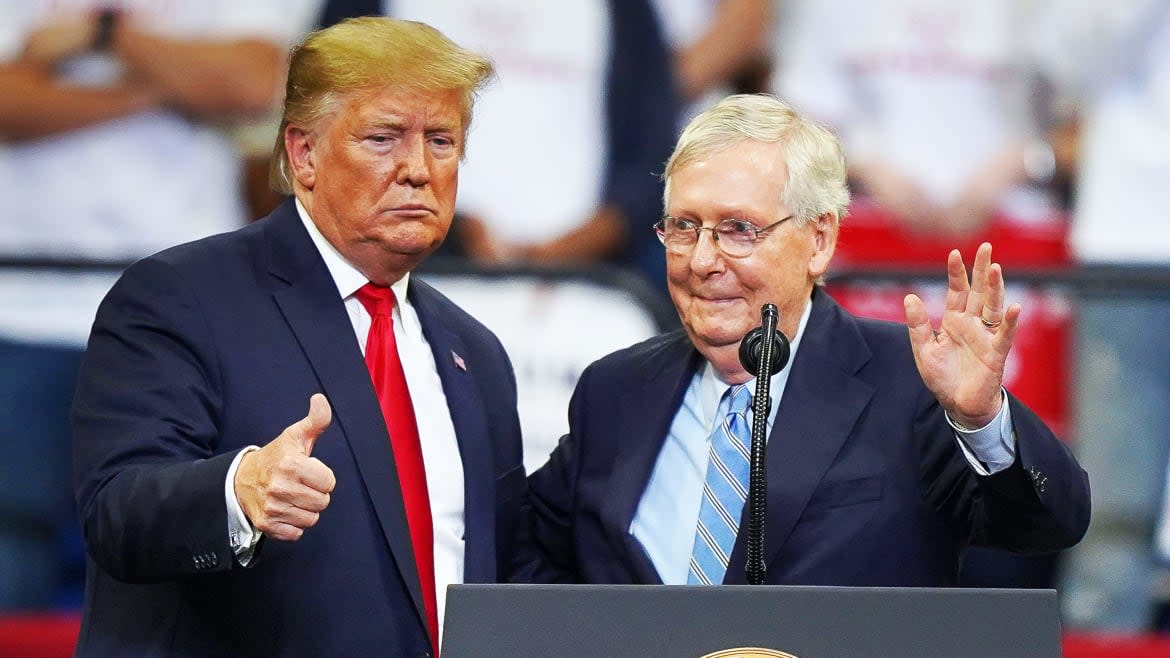Trump’s Last Gasp Could Be a Supreme Court Justice in January

Close your eyes and picture Jan. 3, 2021: The Capitol is teeming with 35 newly sworn-in Senators, four of whom have given the Democrats a 51-50 majority with the vice president-elect’s tie-breaking vote; Republican Senate rule has ended and, with their enlarged House majority, Democrats now control both branches of government for the first time in twelve years.
President-elect Biden and his team are busy crafting an ambitious legislative program, dealing with transition tasks of agency appointments and anticipated judicial nominations and planning the upcoming inauguration. Democrats are happy. Exciting opportunity is in the air.
But within a few days, the Democrats’ party crashes to a halt with the news that a Supreme Court opening has suddenly materialized, and the opening comes from the progressive wing of the court. The immediate assumption is that the 51-50 Democratic majority will ensure that a new nominee will reflect the judicial profile of her predecessor. Not so fast: Between Jan. 3 and Inauguration Day on Jan. 20, outgoing Vice President Mike Pence will still cast tie-breaking votes. And worse, Donald Trump is the undisputed president until noon on the 20th, able to nominate SCOTUS and other judicial nominees, all lifetime appointments.
Here’s a Preview of America’s 2020 Nightmare if Trump Loses
Trump and Senate Majority Leader Mitch McConnell have quietly assembled a short list of conservative SCOTUS nominees, hoping for a vacancy to arise. Should the opening develop days before the November election, or during the transition period between the election and the Inauguration, Trump and McConnell would be ready to shove through their nominee within days. McConnell’s 2016 rebuke of Obama’s nomination of Merrick Garland to the court—“Let the people decide!”—has been retooled to “We’re still in power!”
As late as Jan. 3, Trump—rejected by American voters—and McConnell, stripped of his abusive leadership powers, would likely be prepared to ram through a SCOTUS nomination that would shift the court’s ideological balance to the far right for a generation to come.
Should that opening occur before Jan. 3, McConnell would certainly use Senate rules and practices to schedule an up-or-down confirmation vote with his 53-47 Republican majority. And even after the new 50-50 Senate is sworn in on Jan. 3, McConnell could potentially use Vice President Pence to break any Democratic effort to organize and prevent a Republican SCOTUS confirmation.
A Far-Fetched Scenario?
As long as the Senate has existed, tradition and bipartisan collegiality have smoothed the transfer of power from one party to the other after an election. Leaders of both parties hashed out committee apportionment, budgets, and so on, during the November-December transition period. The opening day schedule, introduction of priority legislation, and speeches has long been regulated by tradition.
After the 2000 election and its resulting 50-50 split, outgoing Democratic leader Tom Daschle and incoming leader Trent Lott worked to ease partisan differences and hand the leadership reins to Republicans.
But next Jan. 3 may be wildly different. If the November election results in a 50-50 split in the Senate—an entirely likely scenario, with four Democratic pickups and a loss in Alabama—emotions may be raw and even vindictive. The past four years of bitter division and personal hostilities have created a toxic Senate environment.
This scenario has happened before, though with no dire results. After the 2000 election, with a split Senate, Al Gore provided the tie-breaking vote that gave Democrats the majority for the 17 days before George W. Bush’s Inauguration.
Potholes in the Trump/McConnell Path
Senate rules experts doubt that McConnell could attempt to force through a SCOTUS nominee in 17 days or less, citing a number of Senate procedural roadblocks, such as the requirement that a nomination must “lay over” for one week, and that the nomination must be voted out of the Judiciary Committee before Senate floor consideration.
“The majority may be deterred from doing what they want by the institution’s inherited rules of procedure,” notes James Wallner, a senior fellow at the R Street Institute and former executive director of the Senate Steering Committee. “A last-minute effort to confirm a Supreme Court nominee would be extraordinary.”
However, any Senate rule can be overridden by a simple Senate majority vote, a procedure that McConnell has aggressively invoked for the Kavanaugh and Gorsuch nominations. And until noon on Jan. 20, Mike Pence can, as president of the Senate, break any tie vote, and give Republicans a continued majority status to conduct committee business. Senate precedence has given vice presidents a wide berth to exercise that vote.
The potential for a last-minute conservative SCOTUS appointment by a defeated Trump and defanged McConnell is real and frightening. Perhaps one or two Republican Senators would resist such a frantic power grab.
Yet despite a handful of senators who have exhibited a willingness to rise above party and challenge Trump, 50 surviving Republicans may be willing to shove through another conservative justice, or a handful of lower court nominees at the last minute. Certainly an embittered, angry, loser Trump would love nothing more than to use his last days in the White House to deal Democrats a vicious blow.
The only sure prevention of this nightmare rests in a Democratic wave election on Nov. 3 that ejects not only Trump and Pence from the White House, but at least five Republican incumbents as well.
And for good measure, the surprise defeat of the Trump Senate enablers who have gotten us in this mess to start with.
Get our top stories in your inbox every day. Sign up now!
Daily Beast Membership: Beast Inside goes deeper on the stories that matter to you. Learn more.

 Yahoo News
Yahoo News 
